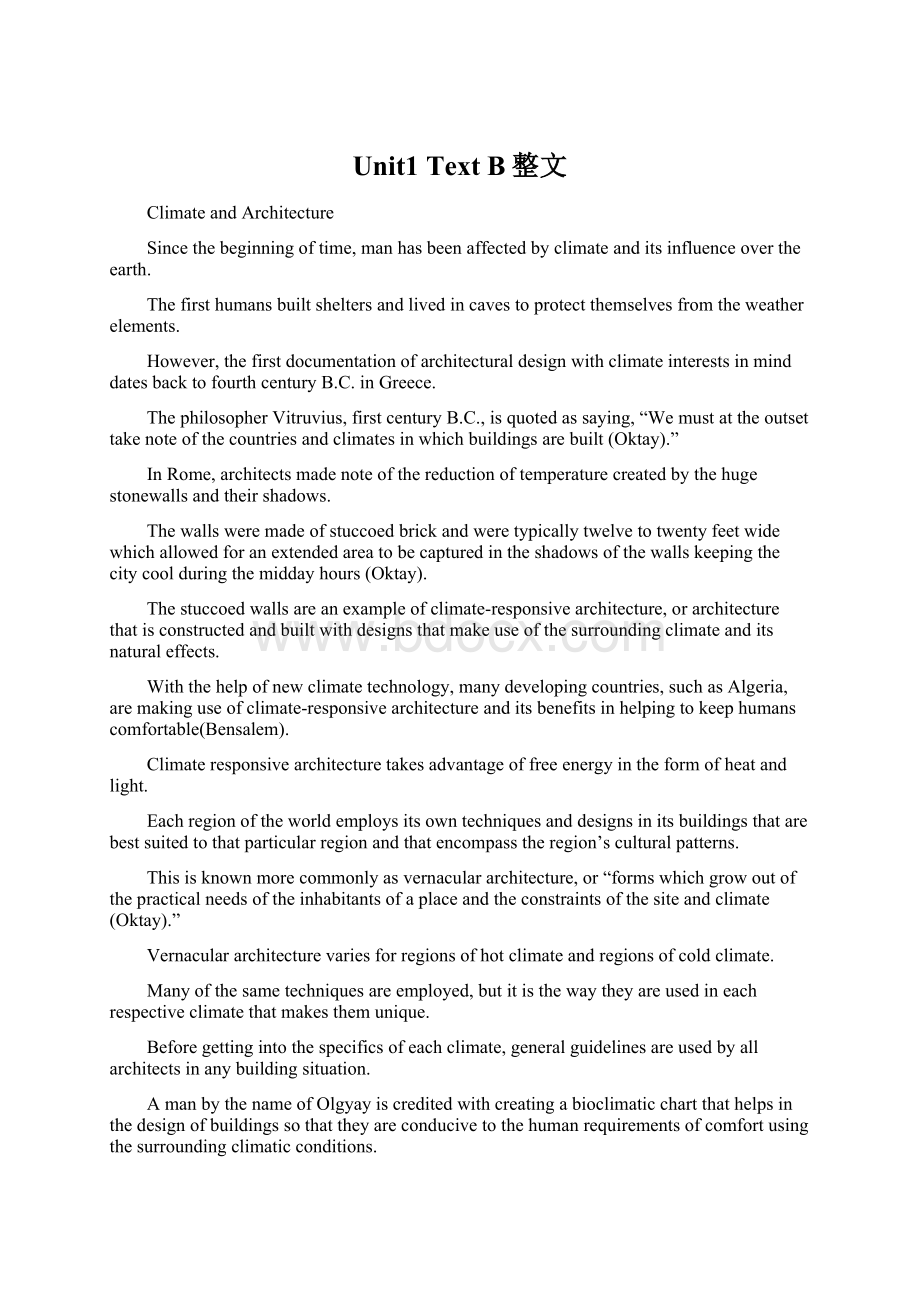Unit1 Text B整文Word格式文档下载.docx
《Unit1 Text B整文Word格式文档下载.docx》由会员分享,可在线阅读,更多相关《Unit1 Text B整文Word格式文档下载.docx(13页珍藏版)》请在冰豆网上搜索。

Thewallsweremadeofstuccoedbrickandweretypicallytwelvetotwentyfeetwidewhichallowedforanextendedareatobecapturedintheshadowsofthewallskeepingthecitycoolduringthemiddayhours(Oktay).
Thestuccoedwallsareanexampleofclimate-responsivearchitecture,orarchitecturethatisconstructedandbuiltwithdesignsthatmakeuseofthesurroundingclimateanditsnaturaleffects.
Withthehelpofnewclimatetechnology,manydevelopingcountries,suchasAlgeria,aremakinguseofclimate-responsivearchitectureanditsbenefitsinhelpingtokeephumanscomfortable(Bensalem).
Climateresponsivearchitecturetakesadvantageoffreeenergyintheformofheatandlight.
Eachregionoftheworldemploysitsowntechniquesanddesignsinitsbuildingsthatarebestsuitedtothatparticularregionandthatencompasstheregion’sculturalpatterns.
Thisisknownmorecommonlyasvernaculararchitecture,or“formswhichgrowoutofthepracticalneedsoftheinhabitantsofaplaceandtheconstraintsofthesiteandclimate(Oktay).”
Vernaculararchitecturevariesforregionsofhotclimateandregionsofcoldclimate.
Manyofthesametechniquesareemployed,butitisthewaytheyareusedineachrespectiveclimatethatmakesthemunique.
Beforegettingintothespecificsofeachclimate,generalguidelinesareusedbyallarchitectsinanybuildingsituation.
AmanbythenameofOlgyayiscreditedwithcreatingabioclimaticchartthathelpsinthedesignofbuildingssothattheyareconducivetothehumanrequirementsofcomfortusingthesurroundingclimaticconditions.
Olgyay’schartisa“zoneofhumancomfortinrelationtoambientairtemperatureandhumidity,meanradianttemperature,windspeed,solarradiation,andevaporativecooling”(Givoni280).
Theaxesofthechartincludethedrybulbtemperatureandrelativehumiditywhichcreatethe“zone”inwhichotherimportantcharacteristicscanbecalculated.
Acomfortzoneiscreatedinthecenterofthechart,whichemphasizesthecorrecttemperatureandhumidityformaximumcomfort.
Thebioclimaticchartisimportantbecauseitallowsbuildersandarchitectstofigureouttherightspecificationsfordesignfactorssuchasorientation,location,size,shading,andform.
Ahot-humidclimateisdefinedasa“regionthatreceivesmorethan20inchesofannualprecipitation”andeitherhas3,000ormorehoursof67degFtemperatureor1,500ormorehoursof73degFtemperatureduringthewarmestsixmonthsoftheyear(BuildingScienceCorporation).
Inthistypeofclimate,themainfunctionofthebuildingsistosimplymoderatethedaytimeheatingeffectsoftheexternalair(Givoni290).
Inotherwords,itisimportanttodesignbuildingswhosestructureandinteriorarebestabletokeepwarmairout.
Livinginahotclimatecanquicklybecomeuncomfortableforitsinhabitantswiththeextremeheatthatisbuiltupbymidday.
Thatiswhyitisimportantforthebuildingsstructurestohaveeffectiveventilationandaninternaltemperaturebelowtheoutdoorlevel(Givoni285).
Theventilationkeepsairmovingthroughtheenvironmentand,therefore,keepstheinhabitantscooler.
Inmanyarid,desertregions,buildingsaredesignedwithflatroofs,smallopenings,andheavyweightmaterials.
Thesematerialsincludedriedmudinruralareasandreinforcedconcreteinurbanareas(Givoni316).
Thethickexteriorroofandwallshelptoabsorbtemperaturefluctuationsand,therefore,keepinternaltemperaturesfromrisingabovetheoutsidesurfacetemperature.
Animportantfunctionoftheroofisitscolor.
Awhiteorlightcoloredroofwillstayapproximatelythesametemperatureastheoutdoorairduringtheday,and6cto10cdegreescoolerthantheoutsideairatnight(Givoni319).
Thisisanimportantfeaturebecausethecoolernighttimeairwillbechanneleddownbythesloopoftheroofandintotheroomsinthebuilding.
Onefunctionofthesmallopeningsistopreventdust,ahugeprobleminAfrica,WestAsia,andWestAustralia,fromenteringbuildings.
Windowsarearrangedsothatequalareasareopenonthewindwardandleewardsidesofthebuilding.
Thereasonforthisisverysimple,theairstreamcanbedirectedintoroomsthatneedconstantventilationsuchasthebedroom(Givoni).
Whenonewindowispositionedhigherthananother,thermalforcewilldirecttheairflowfromthehighwindowtothelowerwindowcreatinggoodventilation.
Courtyards,patios,andverandasareothercommonfeaturesofbuildingsinhotclimates.
Withhighwalls,theseoutsideareasprovideshadeandarelaxingenvironmenttotheirinhabitantsforsocialgatherings,eveningentertainment,foodpreparation,anddomesticworksuchaslaundry(Oktay).
Concreteisthemostcommonmaterialusedinthewallsbecauseithaslowcostandhighthermalcapacitywhichinturnreducesinternaltemperatures(Givoni316).
Anotherwaytoprovideshadeinamoreaestheticallypleasingwayisthroughgreenery.
Forexample,trees,shrubs,andbushesprovidenaturalshadefromthesunwhilegivingthecourtyardareaapleasinglook.
Whyaretheseoutsideareassoimportant?
Theyareimportantbecauseessentialfunctionshappenoutsidelikecookingandentertaining.
Theoutsideenvironmentinhotregionsisjustasimportantastheinsidebecauseitisadaytimerelieffromtheintenseclimate.
Thefollowingchartwascreatedtoshowtheoptimalcomforttemperatureforanoutsideareainahotregion.
Asonecansee,dependingontheorientationofthebuilding,thereisadifferentcorrespondingoptimaltemperature(Bensalem).
Generallybetweentheafternoonhoursoftheday(1:
00pmto4:
00pm),themostcomfortabletemperatureisaround30-35degreesC.
Insummary,atypicalhotclimatebuildingpossessesthreemainsections,amainbuilding,aservicebuilding,andaninnercourtyard(Oktay).
Themainbuildingwillcontainthelivingroomsoastomakeuseofthecrossventilationfromthewindowsandhasanorth-southorientationispreferabletodealwithventilationissues.
Theoutsideareasproviderelieffromheatwiththick,concretewalls.
Acoldclimateisdefinedasaregionwithapproximately5,400to9,000heatingdegree-days(BuildingScienceCorporation).
Aheatingdegree-dayiscalculatedbysubtractingthemeantemperatureforthedayfrom65degF.
Itisgeneralbeliefthatwhenthetemperaturedropsbelow65degF,peoplebegintoturnontheirfurnaces,sothereforewhenthemeantemperaturedropsbelow65degFthedayisassignedaheatingdegreenumber.
Abuildingconstructedincoldclimatesshouldideallyhavehealthyandcomfortableindoorthermalconditionsandareasonablefueleconomywiththeheatingmethodslocallyemployed(Givoni291).
Thekeytoreachingthatgoalisgoodinsulationandsunshineexposure,whichhelpstokeepthewarmairinsidethebuilding.
TheancientGreeksemployedthistechniquebyrealizingthatthewintersunhadalowarcinthesouthernsky,duetothetiltintheEarthattheseason,allowingwindowsinthewallstocapturemuchneededheatfromthesun(Oktay).
Atraditionalbuildingisusuallybuiltjustbelowthebrowofahillonthesouthwardslope.
Thiswaythebuildingisprotectedbythehillandbysurroundingshelterbeltsoftrees(Oktay).
Thenorthfaceofthebuildingtypicallyhasfewopeningswhilethesouthcontainsthemainopeningstomaximizesunexposure.
Orientationisimportantbecauseitaffectswhichsidesofthebuildingsreceivethemostsunlightandhowlongthesunstayswiththosesides.
Thelongaxisofthebuildingshouldideallystretcheasttowest.
Thenorthendreceivestheleastamountofsunlightand,consequently,haslowertemperatures(Oktay).
Thisiswhystoragerooms,toilets,andkitchenstypicallyarelocatedatthenorthendofmanybuildings.
Thesouthendismuchwarmerandgenerallywillhousethelivingroom,bedrooms,andstudyareas.
Tominimizeandreduceheatlossmanyroomscontainlowceilings,thickstonewalls,smallwindows,andcentrallylocatedheating.
Thedifferencebetweenthickwallsincoldandhotclimatesisthatinhotclimatesthewallsoutsidearemeanttoshadetheinteriorfromtheintenseheat,whereas,incoldclimatesthewallsinsidearemeanttoinsulateandkeepheatin.
Thechartbelowwascreatedtoshowtheoptimalcomforttemperatureforacoldregionatdifferenttimesoftheday(Bensalem).
Asdiscussedearly,thechartshowsthatthesouthendofthebuildinginacoldregionisinfactwarmerthantheotherendsofthebuilding,especiallyinthemidafternoonhoursoftheday(1:
00pm).
Manysettlements,likeTheDechrasettlementsinItaly,clustertheirhousesclosetogetherfacingthesouthinordertominimizeheatloss(Bensalem).
InAustria,forexample,thermalinsulationmustbecalculatedbasedontheaverageannualminimumoutdoortemperature(Givoni280).
Whereinothercountries,housesareconstructedbasedonadetailedscalethathelpsdecidehowmuchinsulationisreallyrequired.
Inacoldclimate,usingtherighttyp